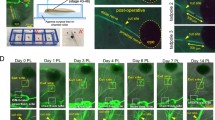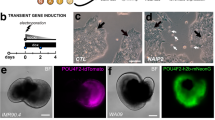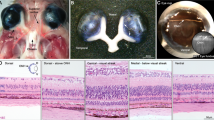Abstract
Optic nerve injury (ONI) induces retinal ganglion cell (RGC) death and optic nerve atrophy that lead to visual loss. Apoptosis signal-regulating kinase 1 (ASK1) is an evolutionarily conserved mitogen-activated protein kinase (MAPK) kinase kinase and has an important role in stress-induced RGC apoptosis. In this study, we found that ONI-induced p38 activation and RGC loss were suppressed in ASK1-deficient mice. Sequential in vivo retinal imaging revealed that post-ONI treatment with a p38 inhibitor into the eyeball was effective for RGC protection. ONI-induced monocyte chemotactic protein-1 production in RGCs and microglial accumulation around RGCs were suppressed in ASK1-deficient mice. In addition, the productions of tumor necrosis factor and inducible nitric oxide synthase in microglia were decreased when the ASK1-p38 pathway was blocked. These results suggest that ASK1 activation in both neural and glial cells is involved in neural cell death, and that pharmacological interruption of ASK1-p38 pathways could be beneficial in the treatment of ONI.
Similar content being viewed by others
Log in or create a free account to read this content
Gain free access to this article, as well as selected content from this journal and more on nature.com
or
Abbreviations
- ASK1:
-
apoptosis signal-regulating kinase 1
- BDNF:
-
brain-derived neurotrophic factor
- GLAST:
-
glutamate/aspartate transporter
- iNOS:
-
inducible nitric oxide synthase
- JNK:
-
c-Jun N-terminal kinase
- LPS:
-
lipopolysaccharide
- MAPK:
-
mitogen-activated protein kinase
- MCP-1:
-
monocyte chemotactic protein-1
- MIP-1α:
-
macrophage inflammatory protein 1α
- NO:
-
nitric oxide
- OCT:
-
optical coherence tomography
- ONI:
-
optic nerve injury
- RANTES:
-
regulated on activation, normal T-cell expressed and secreted
- RGC:
-
retinal ganglion cell
- TLR4:
-
Toll-like receptor 4
- TNF:
-
tumor necrosis factor
- TUNEL:
-
terminal deoxynucleotidyl transferase biotin-dUTP nick-end labeling
References
Perry VH, Henderson Z, Linden R . Postnatal changes in retinal ganglion cell and optic axon populations in the pigmented rat. J Comp Neurol 1983; 219: 356–368.
Harada T, Harada C, Parada LF . Molecular regulation of visual system development: more than meets the eye. Genes Dev 2007; 21: 367–378.
Steinsapir KD, Goldberg RA . Traumatic optic neuropathy. Surv Ophthalmol 1994; 38: 487–518.
Sarkies N . Traumatic optic neuropathy. Eye 2004; 18: 1122–1125.
Levin LA, Beck RW, Joseph MP, Seiff S, Kraker R . The treatment of traumatic optic neuropathy: the International Optic Nerve Trauma Study. Ophthalmology 1999; 106: 1268–1277.
Harada C, Guo X, Namekata K, Kimura A, Nakamura K, Tanaka K et al. Glia- and neuron-specific functions of TrkB signalling during retinal degeneration and regeneration. Nat Commun 2011; 2: 189.
Namekata K, Harada C, Taya C, Guo X, Kimura H, Parada LF et al. Dock3 induces axonal outgrowth by stimulating membrane recruitment of the WAVE complex. Proc Natl Acad Sci USA 2010; 107: 7586–7591.
Namekata K, Harada C, Guo X, Kimura A, Kittaka D, Watanabe H et al. Dock3 stimulates axonal outgrowth via GSK-3β-mediated microtubule assembly. J Neurosci 2012; 32: 264–274.
Sapieha PS, Peltier M, Rendahl KG, Manning WC, Di Polo A . Fibroblast growth factor-2 gene delivery stimulates axon growth by adult retinal ganglion cells after acute optic nerve injury. Mol Cell Neurosci 2003; 24: 656–672.
Kikuchi M, Tenneti L, Lipton SA . Role of p38 mitogen-activated protein kinase in axotomy-induced apoptosis of rat retinal ganglion cells. J Neurosci 2000; 20: 5037–5044.
Brown GC . Nitric oxide and neuronal death. Nitric Oxide 2010; 23: 153–165.
Nishitoh H, Kadowaki H, Nagai A, Maruyama T, Yokota T, Fukutomi H et al. ALS-linked mutant SOD1 induces ER stress- and ASK1-dependent motor neuron death by targeting Derlin-1. Genes Dev 2008; 22: 1451–1464.
Harada C, Namekata K, Guo X, Yoshida H, Mitamura Y, Matsumoto Y et al. ASK1 deficiency attenuates neural cell death in GLAST-deficient mice, a model of normal tension glaucoma. Cell Death Differ 2010; 17: 1751–1759.
Matsuzawa A, Ichijo H . Stress-responsive protein kinases in redox-regulated apoptosis signaling. Antioxid Redox Signal 2005; 7: 472–481.
Guo X, Harada C, Namekata K, Matsuzawa A, Camps M, Ji H et al. Regulation of the severity of neuroinflammation and demyelination by TLR-ASK1-p38 pathway. EMBO Mol Med 2010; 2: 504–515.
Harada C, Nakamura K, Namekata K, Okumura A, Mitamura Y, Iizuka Y et al. Role of apoptosis signal-regulating kinase 1 in stress-induced neural cell apoptosis in vivo. Am J Pathol 2006; 168: 261–269.
Guo L, Normando EM, Nizari S, Lara D, Cordeiro MF . Tracking longitudinal retinal changes in experimental ocular hypertension using the cSLO and spectral domain-OCT. Invest Ophthalmol Vis Sci 2010; 51: 6504–6513.
Nakano N, Ikeda HO, Hangai M, Muraoka Y, Toda Y, Kakizuka A et al. Longitudinal and simultaneous imaging of retinal ganglion cells and inner retinal layers in a mouse model of glaucoma induced by N-methyl-D-aspartate. Invest Ophthalmol Vis Sci 2011; 52: 8754–8762.
Harada T, Harada C, Kohsaka S, Wada E, Yoshida K, Ohno S et al. Microglia–Müller glia cell interactions control neurotrophic factor production during light-induced retinal degeneration. J Neurosci 2002; 22: 9228–9236.
Lehnardt S, Massillon L, Follett P, Jensen FE, Ratan R, Rosenberg PA et al. Activation of innate immunity in the CNS triggers neurodegeneration through a Toll-like receptor 4-dependent pathway. Proc Natl Acad Sci USA 2003; 100: 8514–8519.
Da Silva J, Pierrat B, Mary JL, Lesslauer W . Blockade of p38 mitogen-activated protein kinase pathway inhibits inducible nitric-oxide synthase expression in mouse astrocytes. J Biol Chem 1997; 272: 28373–28380.
Yang G, Meng Y, Li W, Yong Y, Fan Z, Ding H et al. Neuronal MCP-1 mediates microglia recruitment and neurodegeneration induced by the mild impairment of oxidative metabolism. Brain Pathol 2011; 21: 279–297.
Nakazawa T, Nakazawa C, Matsubara A, Noda K, Hisatomi T, She H et al. Tumor necrosis factor-alpha mediates oligodendrocyte death and delayed retinal ganglion cell loss in a mouse model of glaucoma. J Neurosci 2006; 26: 12633–12641.
Munoz L, Ammit AJ . Targeting p38 MAPK pathway for the treatment of Alzheimer’s disease. Neuropharmacology 2010; 58: 561–568.
Yin Y, Henzl MT, Lorber B, Nakazawa T, Thomas TT, Jiang F et al. Oncomodulin is a macrophage-derived signal for axon regeneration in retinal ganglion cells. Nat Neurosci 2006; 9: 843–852.
Kipnis J, Mizrahi T, Hauben E, Shaked I, Shevach E, Schwartz M . Neuroprotective autoimmunity: naturally occurring CD4+CD25+ regulatory T cells suppress the ability to withstand injury to the central nervous system. Proc Natl Acad Sci USA 2002; 99: 15620–15625.
Harada T, Harada C, Nakayama N, Okuyama S, Yoshida K, Kohsaka S et al. Modification of glial–neuronal cell interactions prevents photoreceptor apoptosis during light-induced retinal degeneration. Neuron 2000; 26: 533–541.
Bringmann A, Iandiev I, Pannicke T, Wurm A, Hollborn M, Wiedemann P et al. Cellular signaling and factors involved in Müller cell gliosis: neuroprotective and detrimental effects. Prog Retin Eye Res 2009; 28: 423–451.
Castagne V, Gautschi M, Lefevre K, Posada A, Clarke PG . Relationships between neuronal death and the cellular redox status. Focus on the developing nervous system. Prog Neurobiol 1999; 59: 397–423.
Guo X, Harada C, Namekata K, Kimura A, Mitamura Y, Yoshida H et al. Spermidine alleviates severity of murine experimental autoimmune encephalomyelitis. Invest Ophthalmol Vis Sci 2011; 52: 2696–2703.
Munemasa Y, Ahn JH, Kwong JM, Caprioli J, Piri N . Redox proteins thioredoxin 1 and thioredoxin 2 support retinal ganglion cell survival in experimental glaucoma. Gene Therapy 2009; 16: 17–25.
Tanito M, Kwon YW, Kondo N, Bai J, Masutani H, Nakamura H et al. Cytoprotective effects of geranylgeranylacetone against retinal photooxidative damage. J Neurosci 2005; 25: 2396–2404.
Almasieh M, Lieven CJ, Levin LA, Di Polo A . A cell-permeable phosphine–borane complex delays retinal ganglion cell death after axonal injury through activation of the pro-survival extracellular signal-regulated kinases 1/2 pathway. J Neurochem 2011; 118: 1075–1086.
Yamazaki K, Gohda J, Kanayama A, Miyamoto Y, Sakurai H, Yamamoto M et al. Two mechanistically and temporally distinct NF-kappaB activation pathways in IL-1 signaling. Sci Signal 2009; 2: ra66.
Takeda K, Shimozono R, Noguchi T, Umeda T, Morimoto Y, Naguro I et al. Apoptosis signal-regulating kinase (ASK) 2 functions as a mitogen-activated protein kinase kinase kinase in a heteromeric complex with ASK1. J Biol Chem 2007; 282: 7522–7531.
van Velthoven ME, Faber DJ, Verbraak FD, van Leeuwen TG, de Smet MD . Recent developments in optical coherence tomography for imaging the retina. Prog Retin Eye Res 2007; 26: 57–77.
Chung KF . p38 mitogen-activated protein kinase pathways in asthma and COPD. Chest 2011; 139: 1470–1479.
Kumphune S, Chattipakorn S, Chattipakorn N . Role of p38 inhibition in cardiac ischemia/reperfusion injury. Eur J Clin Pharmacol 2012; 68: 513–524.
Fischer D, Petkova V, Thanos S, Benowitz LI . Switching mature retinal ganglion cells to a robust growth state in vivo: gene expression and synergy with RhoA inactivation. J Neurosci 2004; 24: 8726–8740.
Harada T, Harada C, Watanabe M, Inoue Y, Sakagawa T, Nakayama N et al. Functions of the two glutamate transporters GLAST and GLT-1 in the retina. Proc Natl Acad Sci USA 1998; 95: 4663–4666.
Namekata K, Harada C, Kohyama K, Matsumoto Y, Harada T . Interleukin-1 stimulates glutamate uptake in glial cells by accelerating membrane trafficking of Na+/K+-ATPase via actin depolymerization. Mol Cell Biol 2008; 28: 3273–3280.
Guo X, Nakamura K, Kohyama K, Harada C, Behanna HA, Watterson DM et al. Inhibition of glial cell activation ameliorates the severity of experimental autoimmune encephalomyelitis. Neurosci Res 2007; 59: 457–466.
Acknowledgements
This study was supported by the Ministry of Education, Culture, Sports, Science and Technology of Japan (KN, XG, DK, AK, CH and YM); Takeda Science Foundation (KN); and the Funding Program for Next Generation World-Leading Researchers (NEXT Program) (TH).
Author information
Authors and Affiliations
Corresponding author
Ethics declarations
Competing interests
The authors declare no conflict of interest.
Additional information
Edited by N Bazan
Rights and permissions
About this article
Cite this article
Katome, T., Namekata, K., Guo, X. et al. Inhibition of ASK1-p38 pathway prevents neural cell death following optic nerve injury. Cell Death Differ 20, 270–280 (2013). https://doi.org/10.1038/cdd.2012.122
Received:
Revised:
Accepted:
Published:
Issue date:
DOI: https://doi.org/10.1038/cdd.2012.122
Keywords
This article is cited by
-
Inhibition of p38 ameliorates axonal loss with modulation of autophagy in TNF-induced optic nerve damage
International Ophthalmology (2023)
-
Topical ripasudil stimulates neuroprotection and axon regeneration in adult mice following optic nerve injury
Scientific Reports (2020)
-
Akebia Saponin D prevents axonal loss against TNF-induced optic nerve damage with autophagy modulation
Molecular Biology Reports (2020)
-
Differential effects of N-acetylcysteine on retinal degeneration in two mouse models of normal tension glaucoma
Cell Death & Disease (2019)
-
Role of neuritin in retinal ganglion cell death in adult mice following optic nerve injury
Scientific Reports (2018)



